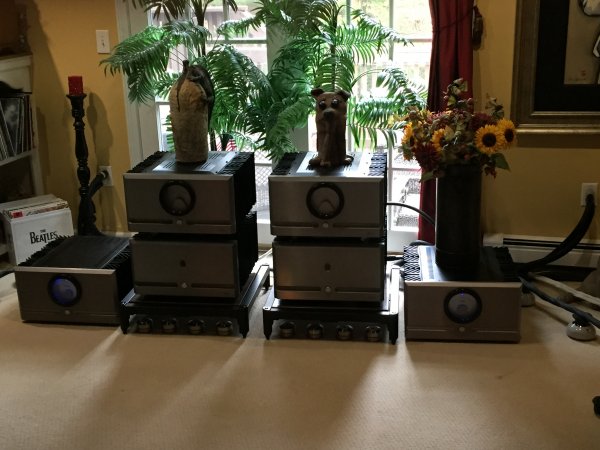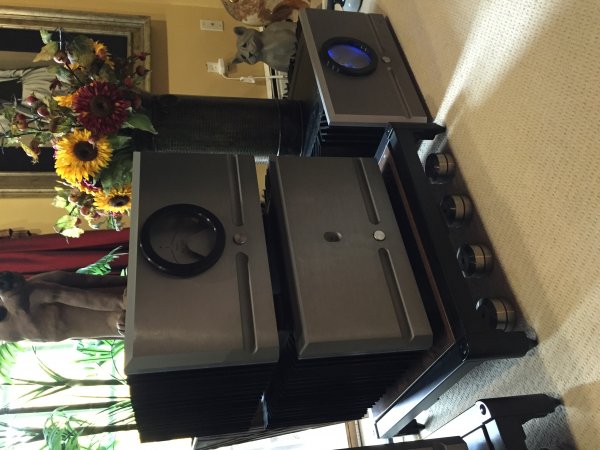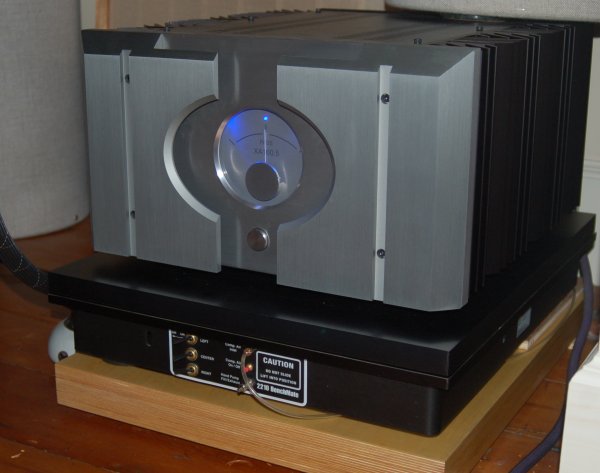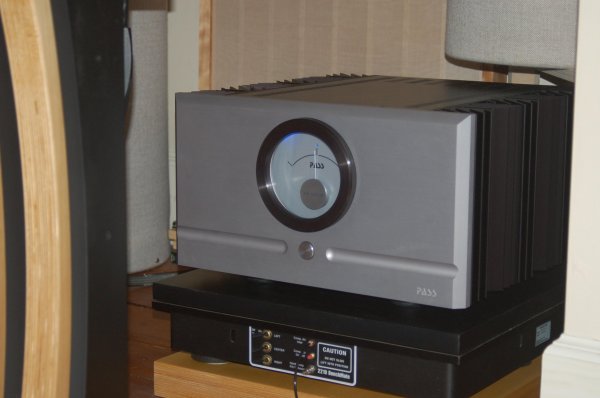I have heard the Pass Labs XS150 amplifiers now in two different systems: Rockitman’s and MadFloyd’s. Christian’s system, room, and most of his music were unfamiliar to me so I could barely begin to understand what these amps contributed to the overall sound. I enjoyed hearing the system, but all I could really conclude was that the amps did a good job driving and controlling his Wilson speakers. However, I know Ian’s system and room quite well, having enjoyed its evolution for the past four years.
Last weekend, fellow member Al M. and I heard Ian’s system again. Ian has both the Pass XA 160.8s and the XS 150s. We compared the two amplifiers directly. To fully appreciate what an accomplishment the XS 150 is, I think it helps to understand how past designs have sounded and how the sound of Pass amps is evolving.
I am a big fan of Pass Labs products and have owned the Aleph 3, Aleph 5, Aleph 2, XA 160, XA100.5, and XA160.5 amplifiers, the Aleph P, X-1, and XP-20 pre amplifiers, and the Ono, XOno, and XP-25 phono amplifiers.
To better understand the XS150, I would like to first describe how the XA160.5 and XA160.8 sound. I directly compared these two amps at Ian’s house and then later at my house.


In Ian’s system: Driving the Magico S5 speakers, the 160.5 sounded smooth, warm, and full bodied. The tone was beautiful, and it was a pleasant non fatiguing sound. The 160.8, by contrast, was more resolving, more controlled, and more dynamic, but it lacked a bit of soul or beauty. It was slightly sterile sounding. In this system, there was a clear difference.
Both amplifiers sounded good for different reasons, but they each had some weaknesses, so, there were trade offs. In this system, I preferred the XA160.8 slightly overall because of the better control and resolution.


In my system: Driving the Magico Mini II speakers, the 160.5 sounded very much like they did at Ian’s house. The sound was smooth, beautiful and non fatiguing, but the amps also had the clarity, drive and control of the 160.8s. Dynamics were great. Perhaps because of the smaller room and smaller, less extended speakers, the 160.5 sounded more complete than they did in Ian’s system. The overall sound was, and is, very natural and convincing. The only advantage the .8s had in my system was slightly better resolution and an ability to better separate the instruments in the most complex music. However, the .8s lacked the tonal beauty and richness of the .5s and did not provide quite the emotional connection to the music that is so critical for me, so I preferred the XA160.5s in my system.
This leads us to XS150. Since the .5 and .8 comparison, Ian replaced the S5s with the Magico M Project speakers. I had heard these new speakers with the XA 160.8 three times before this most recent audition. Ian, Al M. and I began by listening to the XA160.8. The system sounded great. There was good resolution, nice tone, dynamics and presence. It sounded very much like I remember it sounding the last time I heard it, with the major exception of better presence, but that was a result of Ian finding a better speaker location for the M Pros.
We then switched over to the XS150 and listened to the same two tracks that we had just heard with the XA160.8. The sound seemed different and yet familiar at the same time. It had all of the control, resolution and clarity that we heard with the 160.8, but it suddenly also had the rich and warm tone, and overall beauty that I remember hearing with the 160.5 and S5 speakers.
The striking thing is that the XS150 seems to combine the best of these other two amplifiers. It is a little difficult to describe exactly what is going on, but I think that the .8 sounds so clean, vivid and detailed because it resolves a note’s fundamental frequency better than it does its harmonics. The emphasis is on the leading edge and the fundamental. The harmonics are less pronounced and resolved. The sound is less complex and I think this is why it sounds cleaner, crisper and more detailed.
The XA160.5, by contrast, better resolves the note’s harmonics. I think that is why this amp sounds so rich, warm and beautiful.
The greatness of the XS150 is that it resolves the entire note, the fundamental and its harmonics. The transient, sustain and decay are reproduced equally. The sound is more complete. There is an overlap to the sound as old notes decay and new notes begin. Music’s complexity is reproduced in full and the result is an incredible sense of flow and continuousness. The XS has all of the control, speed and resolution of the .8 and all of the richness, warmth and beauty of the .5. It combines the strengths of each amp and has none of their weaknesses.
The XS150 is the highest resolving and most natural sounding amplifier that I have ever heard. It represents the evolution of Pass designs and seems to be the culmination of all of their past best efforts. It is a real achievement.
Last weekend, fellow member Al M. and I heard Ian’s system again. Ian has both the Pass XA 160.8s and the XS 150s. We compared the two amplifiers directly. To fully appreciate what an accomplishment the XS 150 is, I think it helps to understand how past designs have sounded and how the sound of Pass amps is evolving.
I am a big fan of Pass Labs products and have owned the Aleph 3, Aleph 5, Aleph 2, XA 160, XA100.5, and XA160.5 amplifiers, the Aleph P, X-1, and XP-20 pre amplifiers, and the Ono, XOno, and XP-25 phono amplifiers.
To better understand the XS150, I would like to first describe how the XA160.5 and XA160.8 sound. I directly compared these two amps at Ian’s house and then later at my house.


In Ian’s system: Driving the Magico S5 speakers, the 160.5 sounded smooth, warm, and full bodied. The tone was beautiful, and it was a pleasant non fatiguing sound. The 160.8, by contrast, was more resolving, more controlled, and more dynamic, but it lacked a bit of soul or beauty. It was slightly sterile sounding. In this system, there was a clear difference.
Both amplifiers sounded good for different reasons, but they each had some weaknesses, so, there were trade offs. In this system, I preferred the XA160.8 slightly overall because of the better control and resolution.


In my system: Driving the Magico Mini II speakers, the 160.5 sounded very much like they did at Ian’s house. The sound was smooth, beautiful and non fatiguing, but the amps also had the clarity, drive and control of the 160.8s. Dynamics were great. Perhaps because of the smaller room and smaller, less extended speakers, the 160.5 sounded more complete than they did in Ian’s system. The overall sound was, and is, very natural and convincing. The only advantage the .8s had in my system was slightly better resolution and an ability to better separate the instruments in the most complex music. However, the .8s lacked the tonal beauty and richness of the .5s and did not provide quite the emotional connection to the music that is so critical for me, so I preferred the XA160.5s in my system.
This leads us to XS150. Since the .5 and .8 comparison, Ian replaced the S5s with the Magico M Project speakers. I had heard these new speakers with the XA 160.8 three times before this most recent audition. Ian, Al M. and I began by listening to the XA160.8. The system sounded great. There was good resolution, nice tone, dynamics and presence. It sounded very much like I remember it sounding the last time I heard it, with the major exception of better presence, but that was a result of Ian finding a better speaker location for the M Pros.
We then switched over to the XS150 and listened to the same two tracks that we had just heard with the XA160.8. The sound seemed different and yet familiar at the same time. It had all of the control, resolution and clarity that we heard with the 160.8, but it suddenly also had the rich and warm tone, and overall beauty that I remember hearing with the 160.5 and S5 speakers.
The striking thing is that the XS150 seems to combine the best of these other two amplifiers. It is a little difficult to describe exactly what is going on, but I think that the .8 sounds so clean, vivid and detailed because it resolves a note’s fundamental frequency better than it does its harmonics. The emphasis is on the leading edge and the fundamental. The harmonics are less pronounced and resolved. The sound is less complex and I think this is why it sounds cleaner, crisper and more detailed.
The XA160.5, by contrast, better resolves the note’s harmonics. I think that is why this amp sounds so rich, warm and beautiful.
The greatness of the XS150 is that it resolves the entire note, the fundamental and its harmonics. The transient, sustain and decay are reproduced equally. The sound is more complete. There is an overlap to the sound as old notes decay and new notes begin. Music’s complexity is reproduced in full and the result is an incredible sense of flow and continuousness. The XS has all of the control, speed and resolution of the .8 and all of the richness, warmth and beauty of the .5. It combines the strengths of each amp and has none of their weaknesses.
The XS150 is the highest resolving and most natural sounding amplifier that I have ever heard. It represents the evolution of Pass designs and seems to be the culmination of all of their past best efforts. It is a real achievement.
Last edited:

